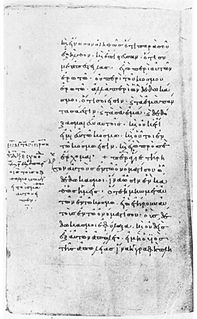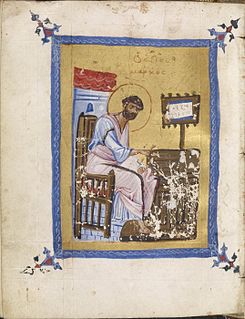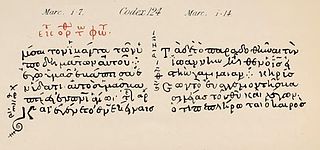
Uspenski Gospels, Minuscule 461, ε 92 (Soden), are a New Testament minuscule manuscript written in Greek, dated at 835 AD. They are the oldest known dated manuscript of the New Testament; it was not customary for Greek scribes to date their work at the time.
Family 13, also known Ferrar Group, is a group of Greek Gospel manuscripts, varying in date from the 11th to the 15th century, which display a distinctive pattern of variant readings — especially placing the story of Jesus and the woman taken in adultery in the Gospel of Luke, rather than in the Gospel of John 7:53-8:11. Text of Luke 22:43-44 is placed after Matt 26:39. The text of Matthew 16:2b–3 is absent. They are all thought to derive from a lost majuscule Gospel manuscript, probably dating from the 7th century. The group takes its name from minuscule 13, now in Paris.

Minuscule 700, ε 133 (Soden), is a Greek minuscule manuscript of the Gospels. Formerly it was labelled as 604 in all catalogues, Gregory gave the number 700 to it. It is dated palaeographically to the 11th century.

Minuscule 124, ε 1211, is a Greek minuscule manuscript of the New Testament, on 188 thick parchment leaves. Palaeographically it has been assigned to the 11th-century. It has marginalia and liturgical matter. The manuscript is quoted in edition of the Novum Testamentum Graece.

Minuscule 1424, δ 30 is a Greek minuscule manuscript of the New Testament, written on 337 parchment leaves. It has been dated paleographically to the 9th or 10th century).
Minuscule 53, ε 444, is a Greek minuscule manuscript of the New Testament, on parchment leaves. Palaeographically it has been assigned to the 13th or 14th century. It has marginalia.
Minuscule 288, ε 524 (Soden), is a Greek minuscule manuscript of the New Testament, on paper. Palaeographically it has been assigned to the 15th century. It has marginalia.
Minuscule 507, ε 142, is a Greek minuscule manuscript of the New Testament, on parchment. Palaeographically it has been assigned to the 11th-century. Scrivener labeled it by number 493. It was adapted for liturgical use.
Minuscule 509, ε 258, is a Greek minuscule manuscript of the New Testament, on parchment. Palaeographically it has been assigned to the 12th century. Scrivener labeled it by number 495.
Minuscule 508, ε 431, is a Greek minuscule manuscript of the New Testament, on parchment. Palaeographically it has been assigned to the 13th-century. Scrivener labelled it by number 494. It was adapted for liturgical use. The manuscript is lacunose.
Minuscule 510, 496, ε 259, is a Greek minuscule manuscript of the New Testament, on parchment. It has been assigned to the 12th century. The manuscript has complex contents. Marginalia are incomplete. It was adapted for liturgical use.
Minuscule 511, ε 342, is a Greek minuscule manuscript of the New Testament, on paper. Palaeographically it has been assigned to the 13th century. Scrivener labelled it by number 497. The manuscript is lacunose, marginalia are complete. It was adapted for liturgical use.
Minuscule 512, ε 441, is a Greek minuscule manuscript of the New Testament, on parchment. Palaeographically it has been assigned to the 14th century. Scrivener labelled it by number 498. The manuscript has complex contents. It was adapted for liturgical use.
Minuscule 514, ε 262 Θε14, is a Greek minuscule manuscript of the New Testament, on parchment. Palaeographically it has been assigned to the 12th century. Scrivener labelled it by number 500. The manuscript has complex contents.
Minuscule 513, ε 261, is a Greek minuscule manuscript of the New Testament, on parchment. Dated by a colophon to the 12th century. Scrivener labeled it by number 499. The manuscript is lacunose. Full marginalia. It was adapted for liturgical use.
Minuscule 515, ε 143, is a Greek minuscule manuscript of the New Testament, on parchment. Palaeographically it has been assigned to the 11th century. Scrivener labelled it by number 501. The manuscript is lacunose. It was adapted for liturgical use.
Minuscule 516, ε 144, is a Greek minuscule manuscript of the New Testament, on parchment. Palaeographically it has been assigned to the 11th century. Scrivener labelled it with the number 502. It was adapted for liturgical use.
Minuscule 517, ε 167 α 214, is a Greek minuscule manuscript of the New Testament, on parchment. Palaeographically it has been assigned to the 11th or 12th century. Scrivener labeled it by number 503. The manuscript is lacunose. It was adapted for liturgical use.
Minuscule 519, ε 343, is a Greek minuscule manuscript of the New Testament, on parchment. Palaeographically it has been assigned to the 13th century. Scrivener labelled it by number 505. The manuscript is lacunose.
Minuscule 520, ε 264, is a Greek minuscule manuscript of the New Testament, on parchment. Palaeographically it has been assigned to the 12th century. Scrivener labelled it by number 506. The manuscript has complex contents.






